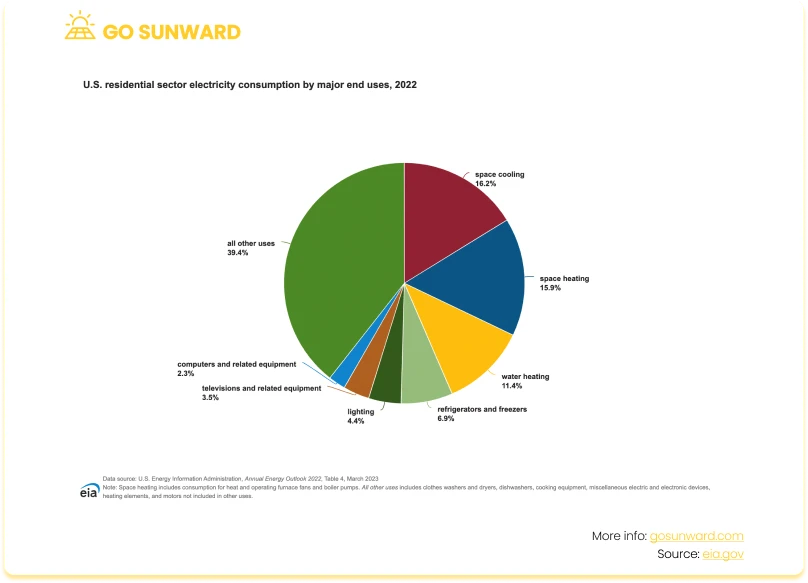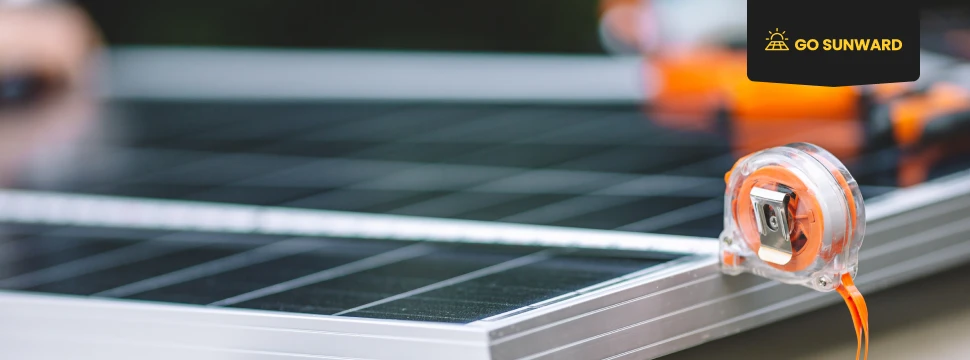What Costs A Lot Of Electricity?
Electricity is crucial in modern life and vital for the US economy. It’s used for lighting, heating, cooling, appliances, electronics, machines, and transportation systems. According to data from the Energy Information Administration (EIA), in 2022, the US used about 4.05 trillion kWh of electricity, the highest ever and 14 times more than in 1950. While future electricity demand is likely to trend slower as gains in energy end-use efficiency offset economic growth, electricity will remain a key cornerstone of society and the economy. That is why it’s important to understand what costs a lot of electricity in your home.
While we rely on this essential resource, it’s important to recognize that certain activities and appliances consume a significant amount of electricity, leading to higher energy bills. In this article, we will focus on residential electricity usage and look closely into the factors that contribute to above average electricity costs, helping you gain a better understanding of where your energy expenses may be coming from. In other articles, we will explore how significant energy or savings can be made at the residential level. To learn about this for the corporate world, ready about solar esg goals here.
So How Much Electricity Do We Really Use?
Before examining what exactly is driving our electricity use at home, it is important to first get a rough understanding of just how much electricity we actually use and how much is costs.
The average electricity usage and cost for a house in the US can vary widely based on factors such as the size of the house, the region it’s located in, the efficiency of appliances, and the local utility rates. As a rough estimate, in 2021, the average annual electricity consumption for a US residential utility customer was 10,632 kWh, an average of about 886 kWh per month (according to the EIA). Louisiana recorded the highest yearly electricity consumption, with 14,302 kWh per residential customer, while Hawaii had the lowest at 6,369 kWh per residential customer.
Moving on to costs, in 2022, the US annual average retail price of electricity was about 12.49¢ per kWh, with average residential electricity prices higher at 15.12¢ per kWh. Residential and commercial consumers typically face the highest retail electricity prices due to the greater distribution costs associated with providing electricity to them. On the other hand, industrial consumers utilize larger amounts of electricity, often at higher voltages, resulting in a more efficient and cost-effective supply process.
It is important to note, that the average cost of electricity varies greatly depending on the region and local utility rates. In 2022, the annual average retail electricity price for all types of electric utility customers ranged from 39.85¢ per kWh in Hawaii to 8.24¢ per kWh in Wyoming. Hawaii’s elevated prices compared to other states primarily stem from the fact that a significant portion of its electricity is produced using imported petroleum fuels.
Energy-saving practices, such as using energy-efficient appliances, improving insulation, and adopting energy-conscious habits, can significantly lower both electricity usage and save money for households. For energy-saving ideas and tips for consumers, see how you can lower your electric bill here.
What Costs A Lot Of Electricity? A Deep Dive Into Residential Electricity Usage
In this section of the article, we’ll examine the top factors driving household electricity usage and costs. We’ll uncover the appliances, habits, and practices contributing heavily to energy usage. We’ve also summarised what costs a lot of electricity in the helpful chart below:

Heating and Cooling Systems
The biggest electricity consumers in residential settings are heating and cooling (air conditioning). These usage patterns are closely tied to weather conditions, leading to variations in their proportion of total annual residential electricity consumption. Air conditioners, heaters, and HVAC units require substantial energy to regulate indoor temperatures, especially during extreme weather conditions. Inefficient insulation, poor maintenance, and extreme temperature settings can all contribute to increased energy consumption, resulting in higher utility bills.
Large Appliances
Appliances like refrigerators, washing machines, and clothes dryers are indispensable in modern households, but they can also be major energy consumers. Old or outdated appliances are often less energy-efficient, causing them to use more electricity to perform the same tasks. Upgrading to energy-efficient models or switching these appliances to run during off-peak hours can help mitigate their energy impact.
Lighting
Although lighting technology has evolved, lighting still accounts for a significant portion of electricity consumption. Traditional incandescent bulbs are particularly inefficient, releasing a substantial amount of energy as heat. Switching to energy-efficient LED bulbs can result in substantial energy savings over time. For more information on LED light bulbs and their energy-saving properties, click here.
Electronics and Gadgets
The proliferation of electronic devices and gadgets has become a staple of modern life, but their constant use contributes to higher energy consumption. Items like computers, televisions, gaming consoles, and chargers consume electricity even when they’re in standby mode. Unplugging devices when not in use or using smart power strips can help curb this “phantom” energy usage.
Electric Vehicles
Recently, electric vehicles have emerged as one of the leading consumers of electricity within households. As more individuals adopt electric vehicles to contribute to sustainability efforts and reduce carbon emissions, the demand for energy to power these vehicles has substantially increased. This shift has transformed the dynamics of household electricity consumption, with a notable portion of daily energy usage now dedicated to powering these vehicles. Consequently, homeowners are increasingly investing in efficient charging infrastructure and exploring smart charging solutions and dedicated EV utility tariffs to manage and optimize their electricity consumption.
Water Heating
Heating water is a substantial energy demand in households and is essential for activities like taking showers, washing dishes, and doing laundry. The energy required for this process is often underestimated, especially when using conventional water heaters. These traditional systems can consume a considerable amount of energy over time, impacting both utility bills and environmental sustainability.
Cooking Appliances
Like ovens, stoves, and microwaves have the potential to impact your energy bills, particularly when you’re cooking often or for extended periods. These appliances consume a considerable amount of energy to generate the heat needed for cooking tasks. If you’re looking to manage your energy expenses, considering your cooking methods can be practical. For instance, using a microwave or a slow cooker can be more energy-efficient compared to traditional cooking methods.
Electric Water Pumps and Motors
In homes with features like swimming pools, hot tubs, or even large-scale irrigation systems, electric water pumps and motors can consume a substantial amount of energy. Regular maintenance, efficient pump models, and conscious usage patterns can help reduce their energy impact.
Poor Insulation and Drafts
A home that is properly insulated plays a critical role in achieving higher levels of energy efficiency. When insulation is lacking and drafts are present, it puts additional strain on heating and cooling systems, compelling them to operate more intensively to uphold the desired indoor comfort levels. Taking proactive steps to rectify issues related to gaps, leaks, and insufficient insulation holds the potential to generate substantial reductions in energy consumption.
Standby and Idle Energy Consumption
In modern households, a notable number of electronic devices and appliances have a tendency to continue drawing power even when they are not actively in use. This phenomenon, often referred to as standby energy consumption, possesses the potential to accumulate over time, leading to unnecessary energy wastage. A practical approach to addressing this issue involves cultivating mindfulness regarding the active status of devices, such as your tv, and making a concerted effort to turn them off when not needed. Additionally, employing smart power strips can be a resourceful solution to curbing this wasteful energy consumption. These power strips are designed to automatically cut off power supply to devices in standby mode, preventing the needless drain of energy.
Conclusion
Acquiring a solid grasp of what costs a lot of electricity in the home is the first crucial step in making informed choices about how we use energy. For instance, items such as air conditioning systems, water heaters, and larger appliances like refrigerators are known to consume a notable portion of electricity. Understanding that these are key contributors to your energy consumption allows you to prioritize where to focus your efforts for maximum impact.
You can also read our 10 energy saving tips you can implement at home.
By smartly recognizing the energy-hungry devices in your home and adopting energy-efficient behaviors, you gain the ability to manage your electricity expenses while also contributing to a greener future. This can involve simple actions such as turning off lights when not in use, unplugging chargers, and utilizing programmable thermostats to optimize heating and cooling cycles.
Moreover, the significance of upgrading appliances to more energy-efficient models cannot be overstated. Modern appliances often come with advanced technologies that consume significantly less energy while delivering the same or even improved performance. From refrigerators to washing machines, these upgrades are long-term investments that pay off in both reduced energy bills and a decreased carbon footprint.




